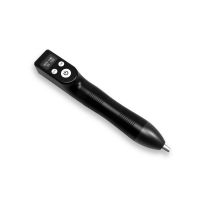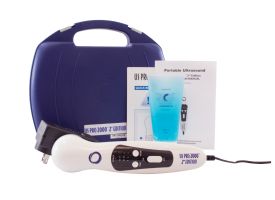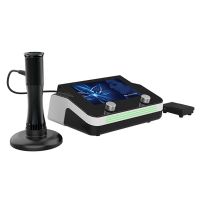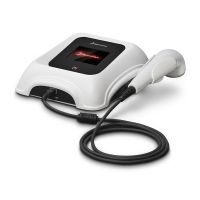 Written by Jessi Cottrell, BSN, RN
Written by Jessi Cottrell, BSN, RN
Whether from overuse, injury, or wear over time, soft tissue pain can limit mobility and prevent you from accomplishing daily life activities. The most common soft tissue injuries affect muscles, tendons, and ligaments.
Pain from conditions like tendinitis, sprains, bursitis, strains, and contusions can disrupt sleep, limit mobility, and generally have a negative impact on quality of life. More than 20% of adults in the U.S. have had chronic pain most days in the past three months. Pain from conditions like tendinitis, sprains, bursitis, strains, and contusions can disrupt sleep, limit mobility, and generally have a negative impact on quality of life.
Shockwave therapy and ultrasound therapy are non-invasive treatments using different forms of wave energy, each supporting the body’s natural healing process. Non-invasive treatments are popular because there is no downtime after a treatment, no side effects that can accompany medication, and no scars or wounds to tend to as the skin is never penetrated.
 | Oceanus PhysioLITE III - Shockwave Therapy Device View Product |
 | Roscoe Medical US Pro 2000 Deep Heat Portable Ultrasound Machine View Product |
Shockwave therapy and ultrasound therapy both use energy waves to stimulate soft tissue healing and reduce pain. Both treatments deliver waves from a power unit to a targeted area with a handheld probe or soundhead. Both shockwave and ultrasound therapies are commonly used in physical therapy and rehabilitation.
Recommended: Oceanus PhysioLITE III - Shockwave Therapy Device
Recommended: Roscoe Portable US Pro 2000 Ultrasound Machine For Therapeutic Use
 | Lotuxs Shockwave Therapy Device View Product |
 | Dynatron 125 Portable Ultrasound with Soundhead by Dynatronics View Product |
The differences between shockwave therapy and ultrasound therapy lie in the frequency of the sound waves, the depth of wave penetration, and whether the waves generate force or heat.
Shockwaves range in frequencies from 1 to 22 kilohertz (kHz), while therapeutic ultrasound has a frequency range of 0.75–3 MHz. Most ultrasound machines are set at a frequency of 1 or 3 MHz. The lower-frequency shockwaves can penetrate more deeply than ultrasound, making shockwave therapy more effective for treating deeper tissue injuries.
Shockwave energy can range from 2 to 7 pounds of pressure per square inch, much more intense pressure than ultrasound which usually can’t even be felt.
The higher energy and deeper tissue penetration of shockwave therapy make it effective in breaking up scar tissue, which is often a cause of chronic pain. A potential downside is that the intensity of the higher-pressure shockwave therapy can cause discomfort or even pain in some users.
The high-frequency ultrasound waves create heat, not force. They are not intense enough to feel. Ultrasound therapy increases blood flow and aids healing of tendinitis and bursitis and reduces arthritis pain, without any discomfort.
Shockwaves do not lose energy through heat as they travel to the treatment area, making shockwaves “cold” technology. In contrast, ultrasound produces heat and the waves lose energy along the path to the treatment target.
Typically, shockwave therapy uses more powerful waves, and its effects are felt sooner than they would be if the same condition was being treated with ultrasound therapy. Utilizing shockwave therapy can lead to fewer treatments, indicating it hastens quicker healing.
Recommended: Lotuxs Shockwave Therapy Device
Recommended: Dynatron 125 Portable Ultrasound with Soundhead by Dynatronics
Your doctor will have the best recommendation for you, and it will depend on what condition is being treated.
Shockwave therapy is best when deep, long-term treatment is required for conditions like bursitis, tendinitis, plantar fasciitis, and damage to the rotator cuff. Ultrasound therapy is most beneficial for aiding recovery from sprains and strains, and it can also treat some skin conditions.
Both shockwave treatments can be used as non-invasive ways to treat injuries and chronic pain, with the most appropriate choice depending on the severity of your pain.
When soft tissue pain is negatively impacting your life and you prefer a non-invasive treatment option, shockwave and ultrasound are both viable therapies.
The lower frequency deep penetrating shockwave treatment is best for breaking up scar tissue and treating deep soft tissue injuries. The intensity of the waves can cause discomfort during treatment, but it can also lead to shorter healing times. The warming ultrasound waves don’t travel as deeply, but they do increase blood circulation through heat delivered to the treatment area, supporting healing and pain reduction.
Visit Caregiver University for more product information, caregiver resources, and buyer’s guides to help you research the best fit for your needs.

Jessi Cottrell is a Registered Nurse, copywriter, mother, and avid book reader. Her nurse background includes emergency medicine, psych & trauma, orthopedic surgery, addiction detox & rehabilitation, and school nursing. She has a passion for finding non-pharmacological methods to treat pain. This passion is fueled by her experience in addiction medicine as well as her own experiences with pain management after various surgeries.